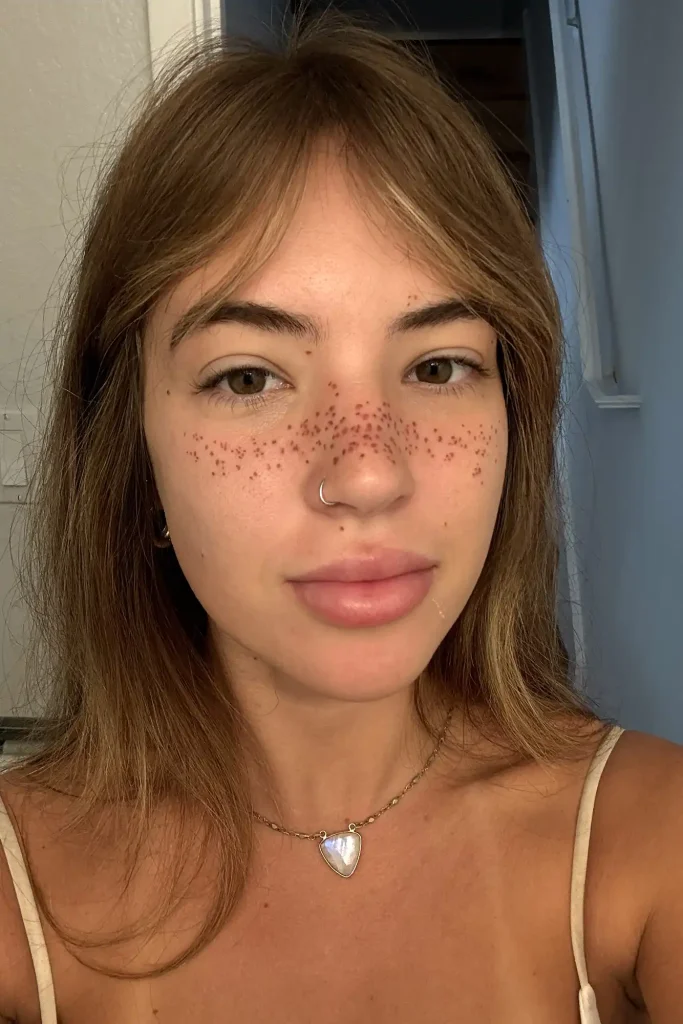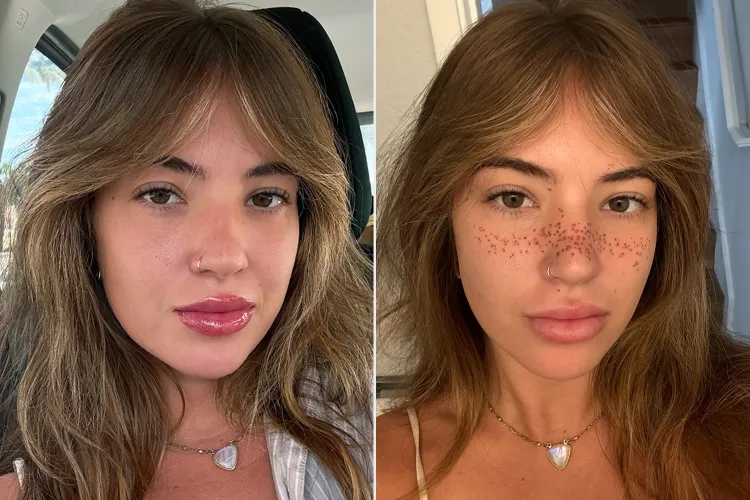26-Year-Old’s Impulsive Decision to Get Tattooed Freckles Sparks Internet Debate — “I Don’t Regret It, Even If They Think I Ruined My Face”
When 26-year-old Sierra Cannon walked into a cosmetic tattoo studio one summer afternoon, she thought she was finally doing something fun — something she’d been dreaming about for years. The soft, scattered freckles she admired on others had always felt like a missing piece of her look, the kind of effortless beauty she’d tried to recreate countless times with makeup, fake tans, and even henna pens. But this time, she wanted something more permanent. Something real. “I just decided to do it,” Sierra said later in a video she shared online. “It was impulsive, but it felt right.”

Within hours of sharing her new look on social media, her photos began to spread far beyond her circle of friends. Some users praised the results, calling her freckles cute, summery, and natural-looking. Others, however, were far less kind. “She ruined her face,” one commenter wrote bluntly. Another said, “Why would anyone do that to themselves?” Thousands of similar remarks poured in — a mix of fascination, judgment, and the kind of cruelty that has become all too common on the internet.
Sierra hadn’t expected her decision to become a viral talking point. What she saw as an aesthetic experiment quickly turned into a storm of public scrutiny. Overnight, she went from an ordinary woman documenting her personal beauty choices to a viral headline — “Woman Gets Tattooed Freckles, Internet Reacts.” In the days that followed, she received both encouragement and condemnation in equal measure, forcing her to confront how something so personal could become public property in the age of viral content.
Freckle tattoos, or “freckling,” as it’s called in the cosmetic world, have become increasingly popular over the last few years. The semi-permanent procedure involves depositing pigment into the skin to mimic natural freckles. For many, it’s a subtle, sun-kissed enhancement that fades over time, blending seamlessly with the skin. But like any cosmetic tattooing, the results depend heavily on technique, skin tone, and aftercare. While professionals emphasize research and caution, Sierra’s decision was spontaneous. “I didn’t overthink it,” she admitted. “I’d seen videos of people getting them done, and I loved how it looked. I just wanted to try it myself.”

The initial healing process wasn’t easy. In the days immediately after the procedure, the freckles appeared darker and more defined than she expected. That’s normal for freshly tattooed skin, but to outsiders who saw her photos during that phase, the effect looked exaggerated. “They were swollen and healing, but everyone thought that was the final result,” she said. The pictures spread fast — reposted, cropped, and captioned with assumptions she couldn’t control.
Online debates about beauty are nothing new, but Sierra’s experience highlights how quickly a simple choice can spiral into a public trial. Many of her critics weren’t just reacting to her appearance; they were voicing larger frustrations about cosmetic trends, authenticity, and the pressure to alter one’s looks for social validation. Some accused her of following fads, while others argued that she was sending the wrong message to young women. “It’s crazy,” Sierra said later. “People were acting like I’d done something irreversible or dangerous, when really, it’s just a semi-permanent tattoo. It fades. It’s not that deep.”
In truth, freckle tattoos do fade — typically lasting one to three years depending on skin type and sun exposure. Over time, the pigment softens, giving a more natural finish. Many clients even return for touch-ups to maintain their desired look. But in Sierra’s case, the online narrative had already taken shape long before that could happen. The internet’s verdict was swift and final: she had “ruined her face.”

Still, Sierra refused to let the criticism define her. Instead of retreating, she chose to respond with transparency, sharing photos of her healing process and explaining what really happens after the procedure. “They look dark at first, but they soften every week,” she said in one follow-up post. “I love how they’re turning out now.” Her videos documenting the progression — from freshly inked dots to soft, natural freckles — began gaining traction, this time from people genuinely curious about the process. Many commented with support, saying her confidence made them rethink their own beauty hang-ups.
This shift in tone reflected something deeper: how social media, despite its harshness, can also create space for open discussion about body autonomy and self-expression. Sierra wasn’t promoting cosmetic tattooing; she was simply owning her choice, a small but powerful statement in an era where every physical change seems to invite collective judgment.
Experts in cosmetic dermatology have since weighed in, noting that procedures like freckle tattoos are safe when done by professionals using proper pigment and sterilization methods. “It’s a form of expression, no different from microblading or permanent eyeliner,” one aesthetic specialist explained. “But clients need to understand that healing takes time and that the internet often reacts to things mid-process.”
For Sierra, that’s exactly what happened — people saw a snapshot, not the full story. “I get why it looked shocking to some people,” she said. “But a lot of the comments were just mean for the sake of being mean. It’s wild how people think they can decide what’s beautiful for someone else.”
Her experience also shines a light on how beauty trends evolve — and how quickly public opinion can turn. Just a few years ago, fake freckles were one of the most viral makeup trends on TikTok, celebrated as a symbol of natural beauty and youthfulness. Influencers dotted their noses with brow pencils and liquid liners, creating playful, sun-kissed looks that millions tried to copy. Yet when someone chose to make that look semi-permanent, the same internet that adored the trend turned on her. The irony wasn’t lost on Sierra. “It’s funny — everyone loves fake freckles until they’re not temporary,” she said with a laugh.
As the weeks passed and her freckles settled into their softer, natural tone, Sierra began to feel more at peace with her decision. “Now, when I look in the mirror, it just feels like me,” she said. “I don’t even notice them anymore. They fit my face.” The harsh comments have quieted, replaced by messages from others who’ve had similar experiences or are considering freckle tattoos themselves. Many thanked her for sharing the process honestly — not filtered, not perfectly lit, just real.
“I think people forget that trends come and go,” Sierra reflected. “What matters is how you feel about yourself. I’m happy. That’s what I wanted.”
Her story has since become a small but meaningful reminder of how quickly personal expression can be judged in a culture obsessed with appearances. It also raises a question that continues to echo across social platforms: who gets to decide what’s beautiful, and why does it matter so much to everyone else?
In the end, Sierra’s freckle tattoos faded just as she expected — and so did much of the outrage surrounding them. What remained, though, was her quiet defiance, her refusal to apologize for something that made her feel good in her own skin. “It’s not that serious,” she said simply. “It’s my face. I get to love it the way I want.”
Her impulsive decision, once mocked and magnified, became something more powerful — a story about ownership, resilience, and the simple truth that beauty, no matter how it’s defined, is always personal. In a world where everyone has an opinion, Sierra Cannon’s story is a reminder that sometimes, the boldest thing you can do is not seek approval at all.



